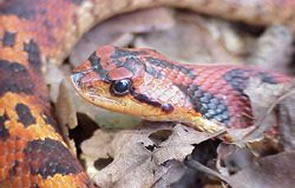
Heterodon platirhinos
Photo by JD Willson
Description: Eastern hognose snakes are stocky snakes whose name is derived from their upturned snout. They are highly variable in color, but are usually patterned above with large brown blotches on a brown or gray background. Some individuals have extensive reddish or orange suffused into the general pattern; some, however, are patternless, appearing solid gray or black. Eastern hognose snakes have keeled scales and can be distinguished from southern hognose snakes by the underside of the tail, which is lighter than the belly.
Feeding/Diet: The hognose snake uses its upturned nose to dig for toads, a favorite food. Enlarged teeth in the rear of the mouth are used to “pop” toads for easier swallowing.
Reproduction: Hognose snakes lay from 5–50 eggs in June and July. The babies hatch about two months later and look like the adults.
Miscellaneous: When threatened, hognose snakes hiss loudly and spread their necks like cobras do, resulting in the nicknames “puff adder” or “spreading adder.” They rarely bite during these displays, but they may strike repeatedly. If the antagonist continues, the hognose snake will feign death by opening its mouth, rolling over on its back, and writhing around. If turned over onto its belly, it will immediately roll again onto its back.

The shaded region represents the range of the eastern hognose snake in North Carolina.

.jpg)

Photo by JD Willson
Playing dead.
Photo
by Pierson Hill
Upturned snout on red phase individual.
Photo by JD Willson



Photo by RW Van Devender
Photo by ME Dorcas
This website created by: J. Willson, Y. Kornilev, W. Anderson, G. Connette and E. Eskew.
For comments or questions contact M. Dorcas: midorcas@davidson.edu.
M. Dorcas homepage: http://bio.davidson.edu/dorcas
Davidson College, Davidson, North Carolina 28035-1719.
Text and maps from: Dorcas, M. E. 2004. A Guide to the Snakes of North Carolina. Davidson College - Herpetology Laboratory, Davidson, NC. – Copyright by Michael E. Dorcas.
Partial Funding for this website provided by a Associate Colleges of the South, National Science Foundation, and Duke Energy.
